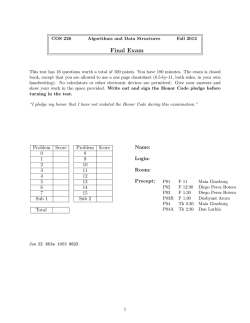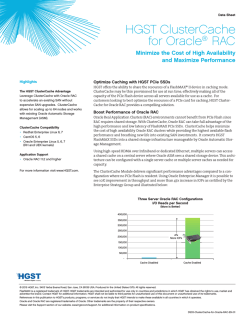
Midterm: Fall 2012 - Princeton University
COS 226
Algorithms and Data Structures
Fall 2012
Midterm
This test has 9 questions worth a total of 55 points. You have 80 minutes. The exam is closed
book, except that you are allowed to use a one page cheatsheet. No calculators or other electronic
devices are permitted. Give your answers and show your work in the space provided. Write out
and sign the Honor Code pledge before turning in the test.
“I pledge my honor that I have not violated the Honor Code during this examination.”
Problem Score
0
1
2
3
4
Sub 1
Problem Score
5
6
7
8
Name:
Login ID:
Room:
Sub 2
Precept:
Total
1
P01
P02
P03
P03B
P04
P04A
F 11
F 12:30
F 1:30
F 1:30
Th 2:30
Th 2:30
Maia Ginsburg
Diego Perez Botero
Diego Perez Botero
Dushyant Arora
Maia Ginsburg
Dan Larkin
2
PRINCETON UNIVERSITY
0. Miscellaneous. (1 point)
In the space provided on the front of the exam, write your name and Princeton NetID; circle
your precept number; write the name of the room in which you are taking the exam; and
write and sign the honor code.
1. Union find. (4 points)
Circle the letters corresponding to id[] arrays that cannot possibly occur during the execution
of the weighted quick union algorithm.
A.
a[i]:
0 1 2 3 4 5 6 7 8 9
---------------------------8 0 4 0 0 4 0 4 2 0
B.
a[i]:
4
1
8
2
1
5
1
1
4
5
C.
a[i]:
3
3
6
9
3
6
3
4
1
9
D.
a[i]:
2
1
1
1
1
1
1
2
1
7
COS 226 MIDTERM, FALL 2012
3
2. Eight sorting algorithms. (8 points)
The column on the left is the original input of strings to be sorted or shuffled; the column
on the right are the strings in sorted order; the other columns are the contents at some
intermediate step during one of the algorithms listed below. Match up each algorithm by
writing its number under the corresponding column. Use each number exactly once.
ENYA
KISS
INXS
STYX
SOAD
ACDC
KORN
FUEL
BUSH
ABBA
WHAM
PINK
BLUR
MUSE
BECK
MOBY
HOLE
TSOL
JAYZ
ENYA
SADE
CARS
DIDO
RUSH
---0
ABBA
ACDC
BECK
BLUR
BUSH
CARS
DIDO
ENYA
ENYA
FUEL
HOLE
INXS
STYX
MUSE
PINK
MOBY
WHAM
TSOL
JAYZ
SOAD
SADE
KISS
KORN
RUSH
----
INXS
HOLE
FUEL
ENYA
ENYA
DIDO
BUSH
BECK
ABBA
ACDC
CARS
BLUR
JAYZ
KISS
KORN
MOBY
MUSE
PINK
RUSH
SADE
SOAD
STYX
TSOL
WHAM
----
(0) Original input
(1) Sorted
(2) Selection sort
(3) Insertion sort
DIDO
CARS
BECK
ACDC
BLUR
ABBA
BUSH
ENYA
ENYA
WHAM
PINK
FUEL
MUSE
KORN
MOBY
HOLE
TSOL
JAYZ
SOAD
SADE
STYX
INXS
RUSH
KISS
----
BUSH
DIDO
CARS
ENYA
BECK
ACDC
BLUR
ABBA
ENYA
FUEL
WHAM
PINK
KORN
MUSE
SOAD
MOBY
HOLE
TSOL
JAYZ
STYX
SADE
INXS
KISS
RUSH
----
BECK
DIDO
CARS
ACDC
BUSH
ABBA
BLUR
ENYA
INXS
KISS
ENYA
PINK
KORN
MUSE
FUEL
MOBY
HOLE
JAYZ
RUSH
SADE
WHAM
SOAD
STYX
TSOL
----
ABBA
ACDC
BUSH
ENYA
FUEL
INXS
KISS
KORN
PINK
SOAD
STYX
WHAM
BECK
BLUR
HOLE
MOBY
MUSE
TSOL
CARS
DIDO
ENYA
JAYZ
RUSH
SADE
----
BLUR
ABBA
DIDO
FUEL
BUSH
ACDC
ENYA
HOLE
ENYA
BECK
INXS
KORN
SADE
CARS
JAYZ
MOBY
SOAD
MUSE
KISS
PINK
STYX
TSOL
RUSH
WHAM
----
ABBA
ACDC
BLUR
BUSH
ENYA
FUEL
INXS
KISS
KORN
MUSE
PINK
SOAD
STYX
WHAM
BECK
MOBY
HOLE
TSOL
JAYZ
ENYA
SADE
CARS
DIDO
RUSH
----
ABBA
ACDC
BECK
BLUR
BUSH
CARS
DIDO
ENYA
ENYA
FUEL
HOLE
INXS
JAYZ
KISS
KORN
MOBY
MUSE
PINK
RUSH
SADE
SOAD
STYX
TSOL
WHAM
---1
(4) Shellsort
(13-4-1 increments)
(7) Quicksort
(Dijkstra 3-way, no shuffle)
(5) Mergesort
(top-down)
(8) Quicksort
(dual-pivot, no shuffle)
(6) Quicksort
(standard, no shuffle)
(9) Heapsort
4
PRINCETON UNIVERSITY
3. Analysis of algorithms. (6 points)
Suppose that you have an array of length 2N consisting of N B’s followed by N A’s.
Below is the array when N = 10.
B B B B B B B B B B A A A A A A A A A A
(a) How many compares does it take to insertion sort the array as a function of N ?
Use tilde notation to simplify your answer.
(b) How many compares does it take to 3-way quicksort the array as a function of N (using
Dijsktra’s 3-way partitioning algorithm)? Use tilde notation to simplify your answer.
COS 226 MIDTERM, FALL 2012
5
4. 3-heaps. (8 points)
A 3-heap is an array representation of a complete ternary tree, where the key in each node is
greater than (or equal to) the keys in each of its children.
(a) Perform a delete-the-maximum operation on the following 3-heap, which is the level-order
traversal of a complete ternary tree, using 1-based indexing.
0
1
2
3
4
5
6
7
8
9
10
11
12
13
14
15
--
88
33
77
66
10
30
25
23
60
75
14
21
50
9
7
Fill in the table below to show the resulting 3-heap, circling any entries that change.
0
1
2
3
4
5
6
7
8
9
10
11
12
13
14
15
--
(b) Given the array index k of a key, what are the indices of its three (potential) children
as a function of k? Assume 1-based indexing and circle your three answers.
(c) What is the maximum number of compares for a delete-the-maximum operation as a
function of the number of keys N in the data structure? Circle the best answer.
∼1
∼ log2 N
∼ log3 N
∼ 2 log3 N
∼ 2 log2 N
∼ 3 log3 N
∼N
6
PRINCETON UNIVERSITY
Midterm, Fall 2012
5. Red-black BSTs. (5 points)
Consider the following left-leaning red-black BST.
51
red link
21
19
13
40
24
88
72
61
96
86
90
Insert the key 99 into the red-black BST and give the level-order traversal of the resulting
BST. Circle the keys who parent link is red.
COS 226 MIDTERM, FALL 2012
7
6. Problem identification. (7 points)
You are applying for a job at a new software technology company. Your interviewer asks you
to identify the following tasks as either possible (with algorithms and data structures learned
in this course), impossible, or an open research problem. You may use each letter once, more
than once, or not at all.
−−−−−
Given any array of N distinct integers, determine whether there
are three integers that sum to exactly zero in time proportional
to N 1.5 .
−−−−−
Given any array of N distinct integers, determine whether there
are three integers that sum to exactly zero in time proportional
to N 2 .
−−−−−
Implement a FIFO queue with a constant amount of memory
plus two LIFO stacks, so that each queue operation uses a constant amortized number of stack operations.
−−−−−
Given any left-leaning red-black BST containing N keys, find
the largest key less than or equal to a given key in logarithmic
time.
−−−−−
Design a priority queue implementation that performs insert,
max, and delete-max in ∼ 31 lg N compares per operation, where
N is the number of comparable keys in the data structure.
−−−−−
Given any array of N keys containing three distinct values, sort
it in time proportional to N and using only a constant amount
of extra space.
−−−−−
Design a practical, in-place, stable, sorting algorithm that guarantees to sort any array of N comparable keys in at most
∼ N lg N compares.
I. Impossible
P. Possible
O. Open
public class LRU<Key, Value>
8
create an empty LRUPRINCETON
cache with capacityUNIVERSITY
N
LRU(int N)
if there are N key-value pairs in the cache, remove the
key (and corresponding value) that was least recently
void (8
put(Key
7. LRU cache.
points)key, Value val) used as an argument to put;
key-value
pairIfinto
LRU structure
cache.
An LRU cache is a data structures that stores insert
up totheNgiven
distinct
keys.
thethedata
is
full when a key not already in the cache is added,
cache first
the key that
returnthe
the LRU
value associated
withremoves
the given key;
Key
get(Key
key)
was least recently cached.
return null if there is no such key-value pair
Design a data structure that supports the following API:
public class LRU<Key>
LRU(int N)
void cache(Key key)
boolean inCache(Key key)
create an empty LRU cache with capacity N
if there are N keys in the cache and the given key is
not already in the cache, (i) remove the key that
was least recently used as an argument to cache()
and (ii) add the given key to the LRU cache
is the key in the LRU cache?
The operations cache() and inCache() should take constant time on average under the
uniform hashing assumption.
For example,
LRU<String> lru = new LRU<String>(5);
// LRU
lru.cache("A");
// A
lru.cache("B");
// B A
lru.cache("C");
// C B
lru.cache("D");
// D C
lru.cache("E");
// E D
lru.cache("F");
// F E
boolean b1 = lru.inCache("C"); // F E
boolean b2 = lru.inCache("A"); // F E
lru.cache("D");
// D F
lru.cache("C");
// C D
lru.cache("G");
// G C
lru.cache("H");
// H G
boolean b3 = lru.inCache("D"); // H G
cache
A
B
C
D
D
D
E
F
D
C
C
A
B
C
C
C
C
E
F
D
D
A
B
B
B
B
B
E
F
F
(in order of when last cached)
(add A to front)
(add B to front)
(add C to front)
(add D to front)
(add E to front)
(remove A from back; add F to front)
(true)
(false)
(move D to front)
(move C to front)
(remove B from back; add G to front)
(remove E from back; add H to front)
(true)
94
COS 226 MIDTERM, FALL 2012
9
Give a crisp and concise English description of your data structure and how the inCache()
and cache() operation are implemented. Your answer will be graded on correctness, efficiency, and clarity.
• Describe your data structure(s). For example, if you use a linear probing hash table,
specify what are the hash table key-value pairs. Also, show (with a small diagram) your
data structure(s) immediately after the sequence of operations on the previous page.
• inCache(Key key):
• cache(Key key):
10
PRINCETON UNIVERSITY
8. Detecting a duplicate. (8 points)
Given k sorted arrays containing N keys in total, design an algorithm that determine whether
there is any key that appears more than once.
Your algorithm should use extra space at most proportional to k. For full credit, it should run
in time at most proportional to N log k in the worst case; for partial credit, time proportional
to N k.
(a) Give a crisp and concise English description of your algorithm.
Your answer will be graded on correctness, efficiency, and clarity.
(b) What is the order of growth of the worst case running time of your algorithm as a
function of N and k? Briefly justify your answer.
N
k log N
N log k
N log N
Nk
N k log k
N k log N
N2
© Copyright 2026





